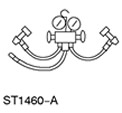Special tool
 | Automatic calibratable halogen leak detector or equivalent |
 | R-134a refrigerant gauge kit or equivalent |
 | Refrigerant ID or equivalent |
WARNING: The work area must be well ventilated before beginning the leak detection procedure. If the ambient air is contaminated with refrigerant gas, the leak detector will always indicate the presence of this gas. Odors from other chemicals such as antifreeze, diesel fuel, disc brake cleaner, or other cleaning solvents will cause the same problems. During the detection of leaks, any movement of air should be excluded.
1.
CAUTION: Refrigerant identification equipment must be used before installing the gauge set, otherwise the gauge set may be contaminated. Contaminated refrigerant must be disposed of as special waste. When working with the service unit, follow the manufacturer's instructions.
NOTE: With the engine off, both gauges should read 4.1-5.5 bar at 24 degrees C.
Connect a set of pressure gauges to the service port valves to check the pressure.
1. To check for leaks, close the manual valves on the gauge set.
2. If low pressure or no pressure is indicated, charge approximately 300 g of refrigerant into the system. For more information, refer to the chapter Repairing, evacuating and charging the air conditioning system (A/C) available in this section.
2. Use an automatic calibrated R134a halogen leak detector to find leaks in the refrigerant system. For information on detecting leaks using the leak detector and how to use this device, see the instructions that came with the leak detector.
3. If a leak is found, repair the A/C system. For more information, refer to the chapter Repairing, evacuating and charging the air conditioning system (A/C) available in this section.
Visitor comments